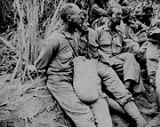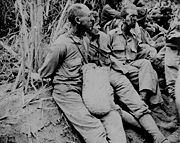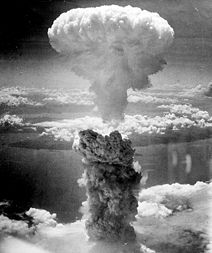
Joe Kieyoomia
Encyclopedia
Joe Kieyoomia was a Navajo
soldier in New Mexico
's 200th Coast Artillery
unit who was captured by the Imperial Japanese Army
after the fall of the Philippines
in 1942 during World War II
. Kieyoomia was a POW in Nagasaki
at the time of the atomic bombing
but survived, reportedly having been shielded from the effects of the bomb by the concrete walls of his cell.
The Japanese tried unsuccessfully to have him decode messages in the "Navajo Code" used by the United States Marine Corps, but although Kieyoomia understood Navajo
, the messages sounded like nonsense to him because the Marine Navajo Code Talkers had developed a series of code words
.
.

 Initially torture
Initially torture
d because his captors thought he was Japanese-American (and therefore a traitor), Joe Kieyoomia suffered months of beatings before the Japanese accepted his claim to Navajo ancestry.
He survived the Death March
that killed thousands of starved U.S. soldiers. When the "Navajo Code" had the Japanese baffled, Kieyoomia was questioned and then tortured, although he could only understand bits and pieces of what trained Navajo Code Talkers were saying, the code was so sophisticated that he eventually told the Japanese that it sounded like nonsense to him.
Kieyoomia was not trained as a code talker and did not know about the code. Stripped naked and made to stand for hours in deep snow until he talked, Joe Kieyoomia's feet froze
to the ground. Finally allowed to return to his cell, a guard shoved him, causing the soles of his feet to tear.
After surviving the prison camp
s, the "hell ship
s" and the torture, Kieyoomia was a prisoner in Nagasaki when that city was the target of the second atomic bomb dropped by US forces. Kieyoomia survived
the attack saying he was protected by the concrete walls of his cell. After 3½ years as a prisoner of war
, he was abandoned for three days after the bombing, but says a Japanese officer finally freed him. He returned to the United States.
Navajo Nation
The Navajo Nation is a semi-autonomous Native American-governed territory covering , occupying all of northeastern Arizona, the southeastern portion of Utah, and northwestern New Mexico...
soldier in New Mexico
New Mexico
New Mexico is a state located in the southwest and western regions of the United States. New Mexico is also usually considered one of the Mountain States. With a population density of 16 per square mile, New Mexico is the sixth-most sparsely inhabited U.S...
's 200th Coast Artillery
200th Coast Artillery (AA) Regiment
The 200th Coast Artillery was a United States Army unit during the first half of World War II. Today descendant elements serve with the New Mexico Army National Guard as the 200th Infantry.-History:...
unit who was captured by the Imperial Japanese Army
Imperial Japanese Army
-Foundation:During the Meiji Restoration, the military forces loyal to the Emperor were samurai drawn primarily from the loyalist feudal domains of Satsuma and Chōshū...
after the fall of the Philippines
Military history of the Philippines during World War II
The Commonwealth of the Philippines was invaded by the Empire of Japan in December 1941 shortly after Japan's declaration of war upon the United States of America, which controlled the Philippines at the time and possessed important military bases there. The combined American-Filipino army was...
in 1942 during World War II
World War II
World War II, or the Second World War , was a global conflict lasting from 1939 to 1945, involving most of the world's nations—including all of the great powers—eventually forming two opposing military alliances: the Allies and the Axis...
. Kieyoomia was a POW in Nagasaki
Nagasaki
is the capital and the largest city of Nagasaki Prefecture on the island of Kyushu in Japan. Nagasaki was founded by the Portuguese in the second half of the 16th century on the site of a small fishing village, formerly part of Nishisonogi District...
at the time of the atomic bombing
Atomic bombings of Hiroshima and Nagasaki
During the final stages of World War II in 1945, the United States conducted two atomic bombings against the cities of Hiroshima and Nagasaki in Japan, the first on August 6, 1945, and the second on August 9, 1945. These two events are the only use of nuclear weapons in war to date.For six months...
but survived, reportedly having been shielded from the effects of the bomb by the concrete walls of his cell.
The Japanese tried unsuccessfully to have him decode messages in the "Navajo Code" used by the United States Marine Corps, but although Kieyoomia understood Navajo
Navajo language
Navajo or Navaho is an Athabaskan language spoken in the southwestern United States. It is geographically and linguistically one of the Southern Athabaskan languages .Navajo has more speakers than any other Native American language north of the...
, the messages sounded like nonsense to him because the Marine Navajo Code Talkers had developed a series of code words
Code (cryptography)
In cryptography, a code is a method used to transform a message into an obscured form, preventing those who do not possess special information, or key, required to apply the transform from understanding what is actually transmitted. The usual method is to use a codebook with a list of common...
.
The capture of the Philippine Islands
The surrender of Bataan would hasten the fall of Corregidor, a month later. However, without this stand, the Japanese might have quickly overrun all of the U.S. bases in the Pacific. Bataan forced them to slow down, giving the allies valuable time to prepare for conflicts such as the Battle of the Coral Sea and the Battle of Midway which followed closely thereafter. Ultimately, more than 60,000 Filipino and 15,000 American prisoners of war were forced into the infamous Bataan Death MarchBataan Death March
The Bataan Death March was the forcible transfer, by the Imperial Japanese Army, of 75,000 American and Filipino prisoners of war after the three-month Battle of Bataan in the Philippines during World War II, which resulted in the deaths of thousands of prisoners.The march was characterized by...
.
Prisoner of war


Torture
Torture is the act of inflicting severe pain as a means of punishment, revenge, forcing information or a confession, or simply as an act of cruelty. Throughout history, torture has often been used as a method of political re-education, interrogation, punishment, and coercion...
d because his captors thought he was Japanese-American (and therefore a traitor), Joe Kieyoomia suffered months of beatings before the Japanese accepted his claim to Navajo ancestry.
He survived the Death March
Bataan Death March
The Bataan Death March was the forcible transfer, by the Imperial Japanese Army, of 75,000 American and Filipino prisoners of war after the three-month Battle of Bataan in the Philippines during World War II, which resulted in the deaths of thousands of prisoners.The march was characterized by...
that killed thousands of starved U.S. soldiers. When the "Navajo Code" had the Japanese baffled, Kieyoomia was questioned and then tortured, although he could only understand bits and pieces of what trained Navajo Code Talkers were saying, the code was so sophisticated that he eventually told the Japanese that it sounded like nonsense to him.
Kieyoomia was not trained as a code talker and did not know about the code. Stripped naked and made to stand for hours in deep snow until he talked, Joe Kieyoomia's feet froze
Frostbite
Frostbite is the medical condition where localized damage is caused to skin and other tissues due to extreme cold. Frostbite is most likely to happen in body parts farthest from the heart and those with large exposed areas...
to the ground. Finally allowed to return to his cell, a guard shoved him, causing the soles of his feet to tear.
After surviving the prison camp
Internment
Internment is the imprisonment or confinement of people, commonly in large groups, without trial. The Oxford English Dictionary gives the meaning as: "The action of 'interning'; confinement within the limits of a country or place." Most modern usage is about individuals, and there is a distinction...
s, the "hell ship
Hell Ship
A hell ship is a ship with extremely unpleasant living conditions or with a reputation for cruelty among the crew. It now generally refers to the ships used by the Imperial Japanese Navy to transport Allied prisoners of war out of the Philippines, Hong Kong and Singapore during World War II. The...
s" and the torture, Kieyoomia was a prisoner in Nagasaki when that city was the target of the second atomic bomb dropped by US forces. Kieyoomia survived
Hibakusha
The surviving victims of the atomic bombings of Hiroshima and Nagasaki are called , a Japanese word that literally translates to "explosion-affected people"...
the attack saying he was protected by the concrete walls of his cell. After 3½ years as a prisoner of war
Prisoner of war
A prisoner of war or enemy prisoner of war is a person, whether civilian or combatant, who is held in custody by an enemy power during or immediately after an armed conflict...
, he was abandoned for three days after the bombing, but says a Japanese officer finally freed him. He returned to the United States.
See also
- Bataan Death MarchBataan Death MarchThe Bataan Death March was the forcible transfer, by the Imperial Japanese Army, of 75,000 American and Filipino prisoners of war after the three-month Battle of Bataan in the Philippines during World War II, which resulted in the deaths of thousands of prisoners.The march was characterized by...
- Military history of the Philippines during World War IIMilitary history of the Philippines during World War IIThe Commonwealth of the Philippines was invaded by the Empire of Japan in December 1941 shortly after Japan's declaration of war upon the United States of America, which controlled the Philippines at the time and possessed important military bases there. The combined American-Filipino army was...
- United States ArmyUnited States ArmyThe United States Army is the main branch of the United States Armed Forces responsible for land-based military operations. It is the largest and oldest established branch of the U.S. military, and is one of seven U.S. uniformed services...
- 200th Coast Artillery (United States)
- Navajo NationNavajo NationThe Navajo Nation is a semi-autonomous Native American-governed territory covering , occupying all of northeastern Arizona, the southeastern portion of Utah, and northwestern New Mexico...
- Navajo languageNavajo languageNavajo or Navaho is an Athabaskan language spoken in the southwestern United States. It is geographically and linguistically one of the Southern Athabaskan languages .Navajo has more speakers than any other Native American language north of the...
- Navajo peopleNavajo peopleThe Navajo of the Southwestern United States are the largest single federally recognized tribe of the United States of America. The Navajo Nation has 300,048 enrolled tribal members. The Navajo Nation constitutes an independent governmental body which manages the Navajo Indian reservation in the...
- Southern Athabaskan languagesSouthern Athabaskan languagesSouthern Athabaskan is a subfamily of Athabaskan languages spoken primarily in the North American Southwest with two outliers in Oklahoma and Texas...
- United States Marine CorpsUnited States Marine CorpsThe United States Marine Corps is a branch of the United States Armed Forces responsible for providing power projection from the sea, using the mobility of the United States Navy to deliver combined-arms task forces rapidly. It is one of seven uniformed services of the United States...

